

06/2005
National Trust, HGTV team up for third year of multimillion dollar program
National Trust for Historic
Preservation President Richard Moe and HGTV President Burton Jablin announced
May 12 that the third year of the multimillion dollar “Restore
America: A Salute to Preservation” partnership will focus on the
role that  preservation plays in the revitalization of communities, and
will support community re-investment projects in 12 cities through
on-air and online programming and grants. The grants are intended to
further the restoration or rehabilitation of a historic structure for
residential use and may be used for professional services or bricks-and-mortar
expenses.
preservation plays in the revitalization of communities, and
will support community re-investment projects in 12 cities through
on-air and online programming and grants. The grants are intended to
further the restoration or rehabilitation of a historic structure for
residential use and may be used for professional services or bricks-and-mortar
expenses.
“The historic and cultural resources of a community tell the story of its past and make each community distinct,” said Moe. “We hope to work with cities and towns across the nation to preserve the physical reminders of our past that are essential for creating a sense of place, and instilling civic pride and community spirit.”
HGTV donated $1 million to fund community revitalization grants. The 12 projects were selected from more than 100 grant applications from nonprofit organizations and public agencies. Recipients have been awarded grants ranging from $25,000 to $100,000. In addition to funding, beginning in October 2005, these new projects will be featured in public-service announcements on HGTV’s networks and on their Web site, exposing them to more than 80 million viewers. HGTV will begin filming at each site in April.
The 12 grants recipients are:
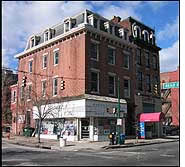 Baltimore: MacGillivrays. Baltimore’s Mt. Vernon neighborhood
saw a number of its elegant mansions converted to medical offices and
apartments, including MacGillivray’s Second Empire townhouse. Prompted
by the prospect of the house’s demolition for a surface parking
lot in the past decade, 18 neighborhood families pooled their resources
to purchase the property, with the hope of restoring the eyesore back
to the community landmark it once was. The Midtown Development Corporation
Inc. will use grant funds to restore MacGillivray’s storefront
and develop six market-rate apartments.
Baltimore: MacGillivrays. Baltimore’s Mt. Vernon neighborhood
saw a number of its elegant mansions converted to medical offices and
apartments, including MacGillivray’s Second Empire townhouse. Prompted
by the prospect of the house’s demolition for a surface parking
lot in the past decade, 18 neighborhood families pooled their resources
to purchase the property, with the hope of restoring the eyesore back
to the community landmark it once was. The Midtown Development Corporation
Inc. will use grant funds to restore MacGillivray’s storefront
and develop six market-rate apartments.
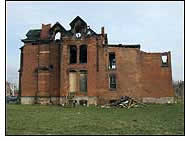 Detroit:
Lucien Moore House. The Modern Gothic Moore House, built in
1885, has witnessed a dramatic neighborhood shift from stately mansions
to apartment buildings in the 1920s and 30s, and, finally, a high incidence
of vacancy, crime, and abandonment that has plagued the neighborhood
since the 1960s. In the late 1990s, the City of Detroit initiated an
aggressive campaign to save the remaining historic properties and promote
community-sensitive infill of the vacant land left by demolition. The
city will use grant funds to restore the Moore house and divide it
into six condos.
Detroit:
Lucien Moore House. The Modern Gothic Moore House, built in
1885, has witnessed a dramatic neighborhood shift from stately mansions
to apartment buildings in the 1920s and 30s, and, finally, a high incidence
of vacancy, crime, and abandonment that has plagued the neighborhood
since the 1960s. In the late 1990s, the City of Detroit initiated an
aggressive campaign to save the remaining historic properties and promote
community-sensitive infill of the vacant land left by demolition. The
city will use grant funds to restore the Moore house and divide it
into six condos.
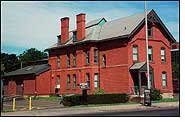 Hartford: The Victorian Lady. This large, 1890 Queen Anne home surely
drew the attention of neighbors, including Mark Twain and Harriet Beecher
Stowe. Over the course of the next 114 years, economic circumstances
transformed the structure into four rental units, an automotive claims
center, and an office and conference center. Facing demolition in 2004,
the Victorian Lady prevailed and was relocated to a vacant lot; hundreds
lined the streets and thousands more watched her slow, one-mile journey
on TV. Northside Institutions Neighborhood Alliance Inc. will use grant
funds to restore the Victorian Lady to its original use as a single-family
home.
Hartford: The Victorian Lady. This large, 1890 Queen Anne home surely
drew the attention of neighbors, including Mark Twain and Harriet Beecher
Stowe. Over the course of the next 114 years, economic circumstances
transformed the structure into four rental units, an automotive claims
center, and an office and conference center. Facing demolition in 2004,
the Victorian Lady prevailed and was relocated to a vacant lot; hundreds
lined the streets and thousands more watched her slow, one-mile journey
on TV. Northside Institutions Neighborhood Alliance Inc. will use grant
funds to restore the Victorian Lady to its original use as a single-family
home.
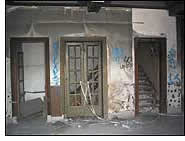 Houston: Jefferson Davis Hospital. The Classical Revival Jefferson Davis
Hospital was the first city-owned hospital in Houston to accept indigent
patients. The four-story hospital opened its doors in 1924, but was soon
rendered inadequate and replaced by a new Jefferson Davis Hospital in
1938.The old hospital served in various functions over the years, but
has been vacant for the past two decades. Artspace Projects Inc. and
Avenue Community Development Corporation will use grant funds to transform
the old Jefferson Davis Hospital into a residential live/work building
filled with 34 units for artists and their families.
Houston: Jefferson Davis Hospital. The Classical Revival Jefferson Davis
Hospital was the first city-owned hospital in Houston to accept indigent
patients. The four-story hospital opened its doors in 1924, but was soon
rendered inadequate and replaced by a new Jefferson Davis Hospital in
1938.The old hospital served in various functions over the years, but
has been vacant for the past two decades. Artspace Projects Inc. and
Avenue Community Development Corporation will use grant funds to transform
the old Jefferson Davis Hospital into a residential live/work building
filled with 34 units for artists and their families.
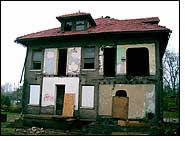 Indianapolis: Efroymson House. This massive beige brick Arts and Crafts
house and matching carriage house were built in 1905. By mid-century,
as the neighborhood began to deteriorate, the Efroymson House was converted
into apartments and then eventually became structurally deficient. After
more than a decade of sitting unoccupied, the house will be adapted into
four apartments in the main house and one in the carriage house by funds
granted to the Historic Landmarks Foundation of Indiana Inc. and the
use of federal and state historic tax credits.
Indianapolis: Efroymson House. This massive beige brick Arts and Crafts
house and matching carriage house were built in 1905. By mid-century,
as the neighborhood began to deteriorate, the Efroymson House was converted
into apartments and then eventually became structurally deficient. After
more than a decade of sitting unoccupied, the house will be adapted into
four apartments in the main house and one in the carriage house by funds
granted to the Historic Landmarks Foundation of Indiana Inc. and the
use of federal and state historic tax credits.
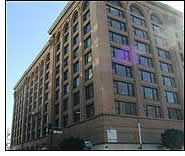 Los Angeles: Pacific Electric Building. Completed in 1905 by famed industrialist
Henry Huntington, the Pacific Electric Building was Los Angeles’ first
skyscraper. Predominately an office building, it also housed an interurban
terminal serving 100,000 passengers per day during World War II. The
rise of the automobile’s popularity rendered the terminal obsolete
by the mid 1960s. Through the early 1980s, the neighborhood and building
declined and the property effectively closed down. Grant funds will be
used by the Los Angeles Conservancy to adapt the 500,000-square-foot
building into 314 loft apartments.
Los Angeles: Pacific Electric Building. Completed in 1905 by famed industrialist
Henry Huntington, the Pacific Electric Building was Los Angeles’ first
skyscraper. Predominately an office building, it also housed an interurban
terminal serving 100,000 passengers per day during World War II. The
rise of the automobile’s popularity rendered the terminal obsolete
by the mid 1960s. Through the early 1980s, the neighborhood and building
declined and the property effectively closed down. Grant funds will be
used by the Los Angeles Conservancy to adapt the 500,000-square-foot
building into 314 loft apartments.
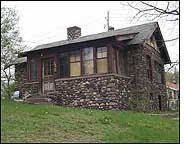 Minneapolis: Martha G. Ripley Maternity
Hospital. In 1886, Dr. Martha
Ripley, one of the first female doctors in the U.S., established a maternity
hospital that welcomed all, without regard to financial status, faith,
or ethnicity and was known across the region for its enviable birth statistics.
The brick building, completed after Ripley’s death in 1912, successfully
operated as a hospital until 1958. Grant funds will be used by the Central
Community Housing Trust to transform the vacant hospital into a variety
of rental and housing units for low- and moderate-income residents.
Minneapolis: Martha G. Ripley Maternity
Hospital. In 1886, Dr. Martha
Ripley, one of the first female doctors in the U.S., established a maternity
hospital that welcomed all, without regard to financial status, faith,
or ethnicity and was known across the region for its enviable birth statistics.
The brick building, completed after Ripley’s death in 1912, successfully
operated as a hospital until 1958. Grant funds will be used by the Central
Community Housing Trust to transform the vacant hospital into a variety
of rental and housing units for low- and moderate-income residents.
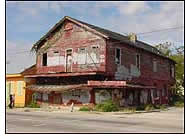 New
Orleans: Incardonia’s. Incardonia’s, a restaurant
and bar run by successful Italian immigrant Joseph Incardonia that
once was a local landmark, currently is vacant and has been
a badly deteriorated eyesore for years. To make the most of the build’s
prominent location on Tchoupitoulas St., grant funds will be used by
Preservation Alliance of New Orleans to convert Incardonia’s
into four residential units with loft-like layouts to appeal to young
buyers and artists.
New
Orleans: Incardonia’s. Incardonia’s, a restaurant
and bar run by successful Italian immigrant Joseph Incardonia that
once was a local landmark, currently is vacant and has been
a badly deteriorated eyesore for years. To make the most of the build’s
prominent location on Tchoupitoulas St., grant funds will be used by
Preservation Alliance of New Orleans to convert Incardonia’s
into four residential units with loft-like layouts to appeal to young
buyers and artists.
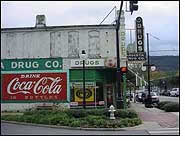 North Little Rock: Argenta Drug Store. Said to be the oldest continuously
operating drug store west of the Mississippi, the Argenta Drug Store
has operated in North Little Rock since 1887. Until the 1950s, the second
floor—now boarded up and used for storage—housed 11 apartments.
The drug store is unique among historic properties in the U.S. due to
its prominent location, original architecture, and exclusive operation
as a pharmacy. Argenta Community Development Corporation will use grant
funds to reopen and rehabilitate the second floor into residential lofts.
North Little Rock: Argenta Drug Store. Said to be the oldest continuously
operating drug store west of the Mississippi, the Argenta Drug Store
has operated in North Little Rock since 1887. Until the 1950s, the second
floor—now boarded up and used for storage—housed 11 apartments.
The drug store is unique among historic properties in the U.S. due to
its prominent location, original architecture, and exclusive operation
as a pharmacy. Argenta Community Development Corporation will use grant
funds to reopen and rehabilitate the second floor into residential lofts.
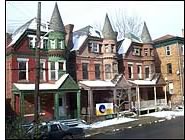 Pittsburgh: 800 Block of Mellon Street. The
three identical Queen Anne turret houses on the 800 block of Mellon Street
were built by Lieutenant James Parker, whose expertise as a wood-crafter
found elegant expression in their highly detailed façades. East Liberty
Development, Inc., will use grant funds to rehabilitate turret houses—which
have steadily deteriorated along with their neighborhood—to provide
quality for-sale units to single-family buyers.
Pittsburgh: 800 Block of Mellon Street. The
three identical Queen Anne turret houses on the 800 block of Mellon Street
were built by Lieutenant James Parker, whose expertise as a wood-crafter
found elegant expression in their highly detailed façades. East Liberty
Development, Inc., will use grant funds to rehabilitate turret houses—which
have steadily deteriorated along with their neighborhood—to provide
quality for-sale units to single-family buyers.
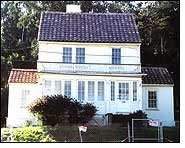 San Francisco: Pilots’ Row. Once headquarters for the Coastal
Artillery Corps that guarded the entrance to the Golden Gate Bridge during
WWI, Pilots’ Row and 13 officers’ quarters were constructed
near an airport built along the Presidio’s north edge. The Presidio
Trust will use grant funds to restore the homes—which have been
vacant for 20 years and need remediation work—for civilian use
and to help preserve a national park and National Historic Landmark District.
San Francisco: Pilots’ Row. Once headquarters for the Coastal
Artillery Corps that guarded the entrance to the Golden Gate Bridge during
WWI, Pilots’ Row and 13 officers’ quarters were constructed
near an airport built along the Presidio’s north edge. The Presidio
Trust will use grant funds to restore the homes—which have been
vacant for 20 years and need remediation work—for civilian use
and to help preserve a national park and National Historic Landmark District.
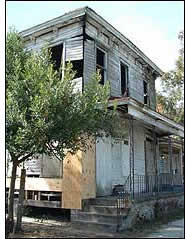 Savannah: Lincoln Street Neighborhood. With a goal to improve livability,
the Lincoln Street initiative, created by the Historic Savannah Foundation,
will use grant funds to focus on restoration of the entire neighborhood
rather than a single property, with emphasis placed on diversity of building
and housing types, home ownership, and rebuilding a sense of place with
the Lincoln Street Neighborhood’s current occupants.
Savannah: Lincoln Street Neighborhood. With a goal to improve livability,
the Lincoln Street initiative, created by the Historic Savannah Foundation,
will use grant funds to focus on restoration of the entire neighborhood
rather than a single property, with emphasis placed on diversity of building
and housing types, home ownership, and rebuilding a sense of place with
the Lincoln Street Neighborhood’s current occupants.
Copyright 2005 The American Institute of Architects.
All rights reserved. Home Page ![]()
![]()
